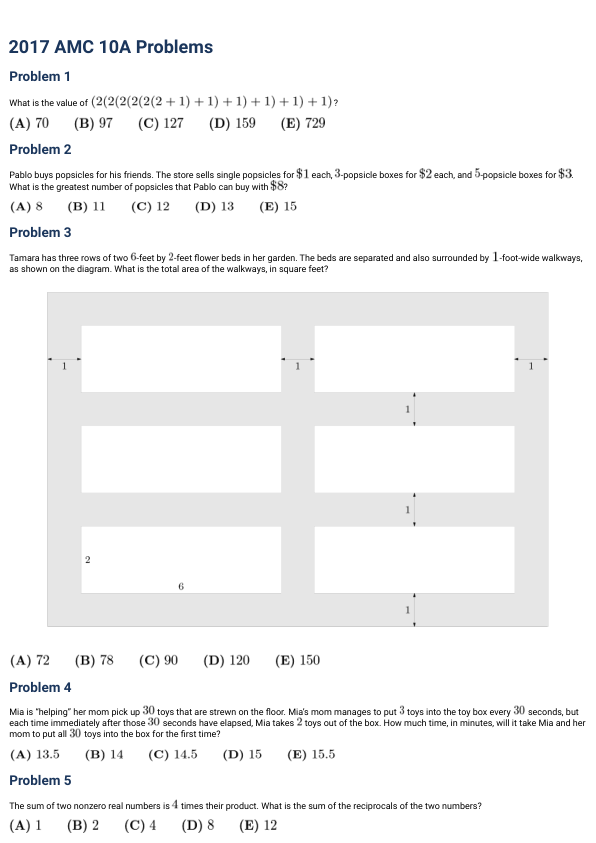2017 AMC amc10a 真题 答案 详解
| 序号 | 文件列表 | 说明 | ||
|---|---|---|---|---|
| 1 | 2017-amc10a-paper-eng-zh.pdf | 10 页 | 522.57KB | 中英双语真题 |
| 2 | 2017-amc10a-paper-eng.pdf | 4 页 | 216.04KB | 英文真题 |
| 3 | 2017-amc10a-key.pdf | 1 页 | 9.98KB | 真题答案 |
| 4 | 2017-amc10a-solution-eng.pdf | 21 页 | 1.39MB | 真题文字详解(英文) |
| 5 | 2017-amc10a-solution-eng-zh.pdf | 21 页 | 1.39MB | 真题文字详解(中英双语) |
| 6 | 2017-amc10a-solution-video-zh.mp4 | 37.78 分钟 | 115.52MB | 真题视频详解(普通话) |
中英双语真题
2017 AMC 10A
Problem 1
What is the value of (2(2(2(2(2(2+1)+1)+1)+1)+1))?
表达式(2(2(2(2(2(2+1)+1)+1)+1)+1))的值是多少?
(A) 70 (B) 97 (C) 127 (D) 159 (E) 729
Problem 2
Pablo buys popsicles for his friends. The store sells single popsicles for $1 each, 3-popsicle boxes for $2 each, and 5-popsicle boxes for $3. What is the greatest number of popsicles that Pablo can buy with $8?
Pablo 给他的朋友买棒冰,商店单根棒冰卖 1 美元一根,1 盒 3 根棒冰每盒卖 2 美元,1 盒 5 根棒冰每盒卖 3 美元。Pablo 有 8 美元,最多可以买多少根棒冰?
(A) 8 (B) 11 (C) 12 (D) 13 (E) 15
Problem 3
Tamara has three rows of two 6-feet by 2-feet flower beds in her garden. The beds are separated and also surrounded by 1-foot-wide walkways, as shown on the diagram. What is the total area of the walkways, in square feet?
Tamara 的花园里 6 英尺 x 6 英尺规格的花床有 3 行,每行 2 个。如下图所示,花床被 1 英尺宽的走道分隔和包围。走道的总面积是多少平方英尺?
(A) 72 (B) 78 (C) 90 (D) 120 (E) 150

英文真题
2017 AMC 10A Problems
Problem 1
What is the value of (2(2(2(2(2(2+1)+1)+1)+1)+1))?
((A) \quad 70 \quad (B) \quad 97 \quad (C) \quad 127 \quad (D) \quad 159 \quad (E) \quad 729)
Problem 2
Pablo buys popsicles for his friends. The store sells single popsicles for $1 each, 3-popsicle boxes for $2 each, and 5-popsicle boxes for $3. What is the greatest number of popsicles that Pablo can buy with $8?
((A) \quad 8 \quad (B) \quad 11 \quad (C) \quad 12 \quad (D) \quad 13 \quad (E) \quad 15)
Problem 3
Tamara has three rows of two 6-feet by 2-feet flower beds in her garden. The beds are separated and also surrounded by 1-foot-wide walkways, as shown on the diagram. What is the total area of the walkways, in square feet?
((A) \quad 72 \quad (B) \quad 78 \quad (C) \quad 90 \quad (D) \quad 120 \quad (E) \quad 150)
Problem 4
Mia is "helping" her mom pick up 30 toys that are strewn on the floor. Mia's mom manages to put 3 toys into the toy box every 30 seconds, but each time immediately after those 30 seconds have elapsed, Mia takes 2 toys out of the box. How much time, in minutes, will it take Mia and her mom to put all 30 toys into the box for the first time?
((A) \quad 13.5 \quad (B) \quad 14 \quad (C) \quad 14.5 \quad (D) \quad 15 \quad (E) \quad 15.5)
Problem 5
The sum of two nonzero real numbers is 4 times their product. What is the sum of the reciprocals of the two numbers?
((A) \quad 1 \quad (B) \quad 2 \quad (C) \quad 4 \quad (D) \quad 8 \quad (E) \quad 12)

真题文字详解(英文)
Problem 1 What is the value of $(2(2(2(2(2(2+1)+1)+1)+1)+1)+1)?
(A) 70 (B) 97 (C) 127 (D) 159 (E) 729
Solution 1
Notice this is the term $a_6$ in a recursive sequence, defined recursively as $a_1=3$, $a_n=2a_{n-1}+1$. Thus:
$a_2 = 3 \cdot 2 + 1 = 7$.
$a_3 = 7 \cdot 2 + 1 = 15$.
$a_4 = 15 \cdot 2 + 1 = 31$.
$a_5 = 31 \cdot 2 + 1 = 63$.
$a_6 = 63 \cdot 2 + 1 =$ (C) 127
Minor LaTeX edits by fasterthanlight
Solution 2
Starting to compute the inner expressions, we see the results are $1, 3, 7, 15, \ldots$. This is always $1$ less than a power of $2$. The only admissible answer choice by this rule is thus (C) 127
Solution 3
Working our way from the innermost parenthesis outwards and directly computing, we have (C) 127
Solution 4
If you distribute this you get a sum of the powers of $2$. The largest power of $2$ in the series is $64$, so the sum is (C) 127
Solution 5
$(2(2(2(2(2(2+1)+1)+1)+1)+1)+1)=(2(2(2(2(2(3)+1)+1)+1)+1)= (2(2(2(2(7)+1)+1)+1)= (2(2(2(14)+1)+1)+1)= (2(2(30)+1)+1)= (2(62)+1)+1)= (2(63)+1)= (126+1)= 127\Rightarrow(C)127$
Solution 6 (quickest)
Notice that $x^6+x^5+x^4+x^3+x^2+x+1=x(x(x(x(x(x+1)+1)+1)+1)+1)+1$. Substituting $2$ for $x$, we get
$2(2(2(2(2(2+1)+1)+1)+1)+1)=2^6+2^5+2^4+2^3+2^2+2+1=2^7-1\Rightarrow(C)127$
Solution 7 (Fast)
Notice that there are $5$ instances where the sum is multiplied by $2$. That gives us $2^5=32$. Separate the addition part into $3$ and the $1$. Multiply the $3$ by $32$, giving $96$. Then notice that the $1$ is multiplied by increasing powers of two; therefore, it is equal to $2^5-1$. Then add these two parts. $96+31=(C)127$
Problem 2 Pablo buys popsicles for his friends. The store sells single popsicles for $\$$1 each, $3$-popsicle boxes for $\$$2 each, and $5$-popsicle boxes for $\$$3. What is the greatest number of popsicles that Pablo can buy with $\$$8?
(A) 8 (B) 11 (C) 12 (D) 13 (E) 15
Solution 1

真题文字详解(中英双语)
Problem 1 What is the value of $(2(2(2(2(2(2+1)+1)+1)+1)+1)$?
$(2(2(2(2(2(2+1)+1)+1)+1)+1)$ 的值是多少?
(A) $70$ (B) $97$ (C) $127$ (D) $159$ (E) $729$
Solution 1
Notice this is the term $a_6$ in a recursive sequence, defined recursively as $a_1=3$, $a_n=2a_{n-1}+1$. Thus:
$a_2 = 3 \cdot 2 + 1 = 7$.
$a_3 = 7 \cdot 2 + 1 = 15$.
$a_4 = 15 \cdot 2 + 1 = 31$.
$a_5 = 31 \cdot 2 + 1 = 63$.
$a_6 = 63 \cdot 2 + 1 =$ (C) $127$
Minor LaTeX edits by fasterthanlight
Solution 2
Starting to compute the inner expressions, we see the results are $1, 3, 7, 15, \ldots$. This is always $1$ less than a power of $2$. The only admissible answer choice by this rule is thus (C) $127$.
Solution 3
Working our way from the innermost parenthesis outwards and directly computing, we have (C) $127$.
Solution 4
If you distribute this you get a sum of the powers of $2$. The largest power of $2$ in the series is $64$, so the sum is (C) $127$.
Solution 5
$(2(2(2(2(2(2+1)+1)+1)+1)+1)=(2(2(2(2(2(3)+1)+1)+1)+1)=(2(2(2(2(6+1)+1)+1)+1)=(2(2(2(7)+1)+1)+1)=(2(2(14+1)+1)+1)=(2(62+1)+1)=(2(63)+1)=(126+1)=127\Rightarrow$ (C) $127$
Solution 6 (quickest)
Notice that $x^6+x^5+x^4+x^3+x^2+x+1=x(x(x(x(x(x+1)+1)+1)+1)+1). Substituting $2$ for $x$, we get
$2(2(2(2(2(2+1)+1)+1)+1)+1)=2^6+2^5+2^4+2^3+2^2+2+1=2^7-1\Rightarrow$ (C) $127$
Solution 7 (Fast)
Notice that there are $5$ instances where the sum is multiplied by $2$. That gives us $2^5=32$. Separate the addition part into $3$ and the $1$. Multiply the $3$ by $32$, giving $96$. Then notice that the $1$ is multiplied by increasing powers of two; therefore, it is equal to $2^5-1$. Then add these two parts. $96+31=$ (C) $127$
Problem 2 Pablo buys popsicles for his friends. The store sells single popsicles for $1 each, $3-popsicle boxes for $2 each, and $5-popsicle boxes for $3. What is the greatest number of popsicles that Pablo can buy with $8?
(A) $8$ (B) $11$ (C) $12$ (D) $13$ (E) $15$

